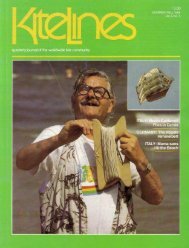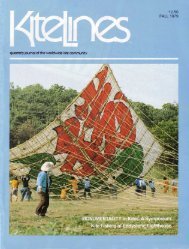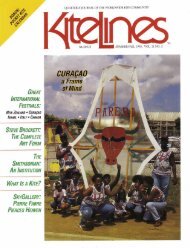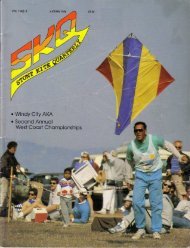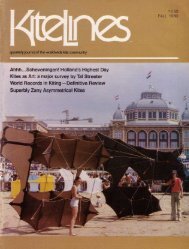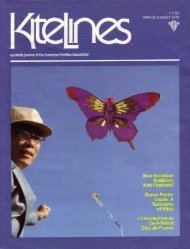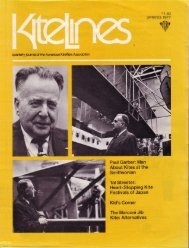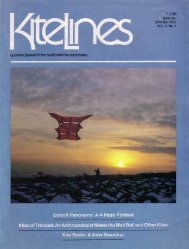Create successful ePaper yourself
Turn your PDF publications into a flip-book with our unique Google optimized e-Paper software.
Countdown of the Bigge trainof sleds, Burtonsville, MD, 1974 .definitive advance in quantity anddemonstrate the real potentialities ofhis system . He believed he could easilyhandle 500 kites, maybe 1000 . At aboutthat time, word was received that Gore,Kudo, in Japan, had flown 204 kiteson one line . So Bigge made more kitesand waited for the first good opportunityto try again . The day came onOctober 5, 1974, in Burtonsville, MD .Despite limited time and somedamage to line from a standard kitethat strayed into the area, the countdownof the sparkling little kites,verified by seven witnesses, was 261 .It was a new world record, and thistime my correspondence with Guinnesspaid off for Bigge . I argued for a newcategory in kiteflying records, on thebasis that altitude and duration wereno more and probably less a technicalchallenge than flying many kites onone line . Further, Yolen's claim to thetitle of "International <strong>Kite</strong> FlyingChampion" was based in part on hisefforts in this area .The 1976 Guinness and Yolen's newvolume, The Complete Book of <strong>Kite</strong>s and<strong>Kite</strong>living came out soon after, in thesame year, with their contradictoryinformation .In January, 1976, Yolen made yetanother effort to attain legitimate renownthrough multikiteflying, butfailed to better even his old count of178 . His coverage again was superlative,including the national radio showMonitor, but in his desire to be equalto the occasion he did not name hisreal competition, Bill Bigge .Meantime, in Japan a reprint of thestory in the Windy <strong>No</strong>tice (newsletterof the Maryland <strong>Kite</strong> Society) appearedin the Japan <strong>Kite</strong> Association magazine. The noted competitiveness ofthat country was thus baited . The followingJuly, Mitsuo Tanaka flew 283kites from one line . Then in <strong>No</strong>vember,1975, a wire service reported thatTanaka had gone to 343 kites in a neweffort when the string snapped . Thoughthis invalidated the attempt as a record,reporters wrote it up anyway, and itthus became a new standard . It was anapparent incentive for Jean Goineau,in Angers, France, to fly 358 kites onone line, according to a wire serviceaccount which appeared in the UnitedStates in late February, 1976 . <strong>No</strong>ne ofthese efforts were nearly so impressive,however, as the 1050 kites flown byKazuhiko Asaba, in Kamakura, Japan,on April 4, 1976 . He was the next tobe officially recognized by Guinness forthat category .There's no question that Japan dominatesthe skies where kite trains areconcerned . Larry Hoffman, our correspondentin Toyko, reports that kitetrain flying is not unusual in Japan .He says that Matsuo Isobe "always hasone with him and usually has about 300to 500 kites up at a minimum . The wifeof another Creative <strong>Kite</strong>s Club memberalmost always has her train diamondsup, several hundred of them ."Lest we forget, in September of 1976,Henry H . Boutwell and crew in NewOrleans laid out 1251 sleds on theground, following a completely newmethod, in an abortive attempt torecapture the record for the UnitedStates . Boutwell employed three branchlines from one main line, a system thatproved to be unworkable . His effortwas well-publicized in his area andhas to rank as one of the most spectacularfailures in the limited historyof this kiteflying specialty .Since then, in Japan there has beenmore than one new multikite attempt .The latest of these was an incrediblesweep of 1585 kites on <strong>No</strong>vember 19,1976 . Plastic and bamboo Eddy-typekites about a foot long were run up andthen retrieved in about 4 1/2 hours, asreported in somewhat more detail inthe Spring issue of <strong>Kite</strong> <strong>Lines</strong> . As Iwrite this article, I am willing to saythat the end is not in sight . 0PROPOSED STANDARDS FORMULTIKITEFLYING, WORLD RECORD CLASS• All the kites must fly . To meet this standard,it must be clear that no kite pulls another . Socalled"sky anchors," or large kites launchedfirst, are not recommended nor proper procedure. The first kites out should be attachedto the lightest line, which can then increasein strength as the pull increases .• All kites should be approximately the samesize, again on the principle that no kitepulls another .• All kites must be retrieved . <strong>Kite</strong>s lost orimpaired in flight do not count .• Any number of kitefliers may participate andshare the glory as they choose, though asa matter of convenience in reference it isgood to use a leader's name or chapter orclub name .*An increase of fewer than 10 kites over aprevious record may not be recognized .• Persons making such efforts in the U .S .A.must notify and receive clearance from theFAA in advance .• At least two disinterested parties must witnessthe count and sign a paper giving numberof kites flown, date of effort, and name ornames of kiteflier or kitefliers involved . Optionalinformation may be added about sizeand type of kites used, methods and timeemployed, etc . A copy of the signed papershould be sent to both AKA and Guinnessfor vertification .<strong>No</strong>te : The above standards are not carvedn granite. They are presented here as astarting point, and correspondence on thistopic is encouraged .




